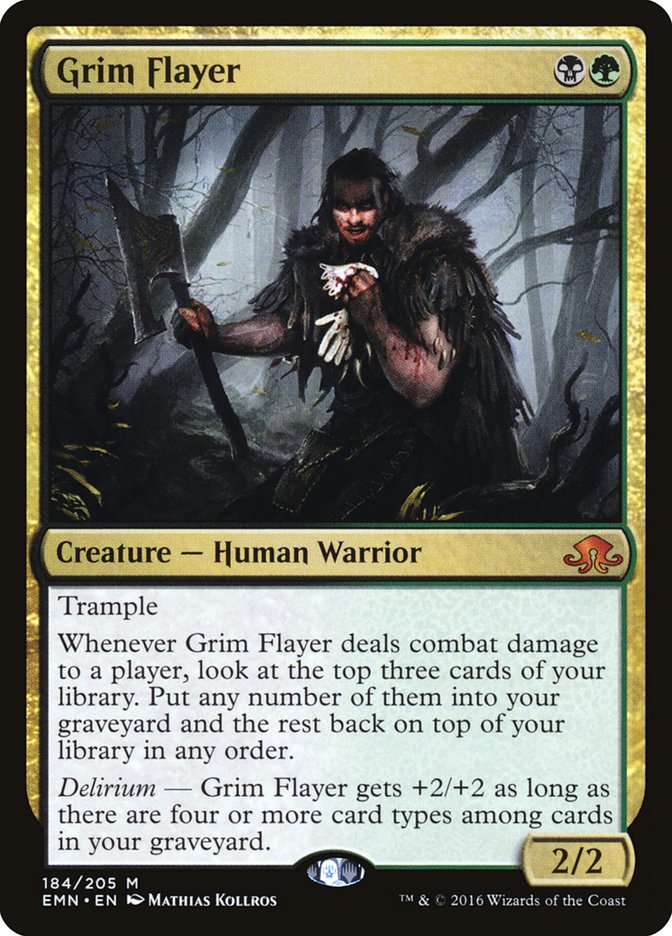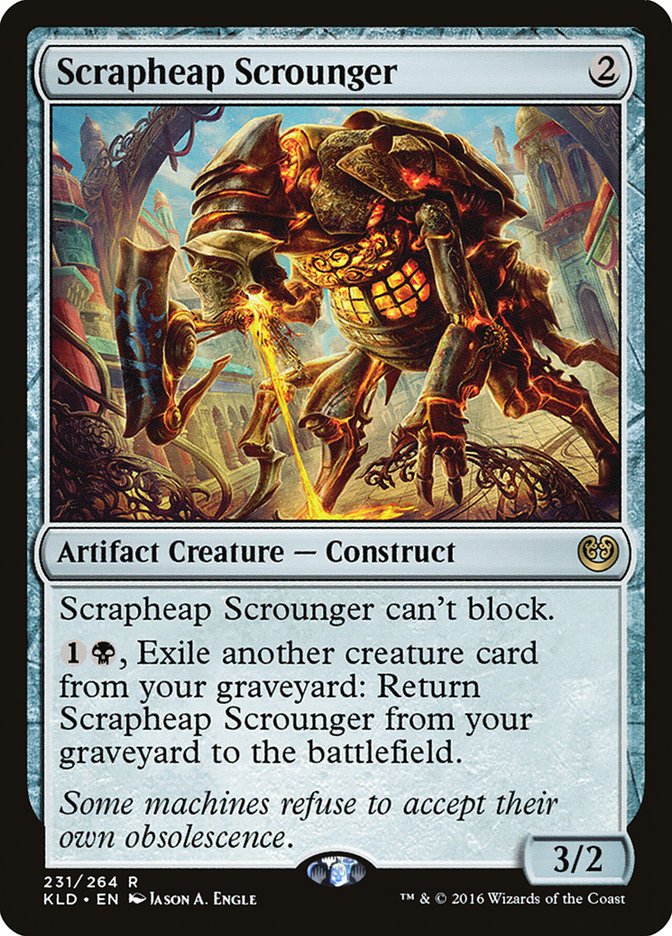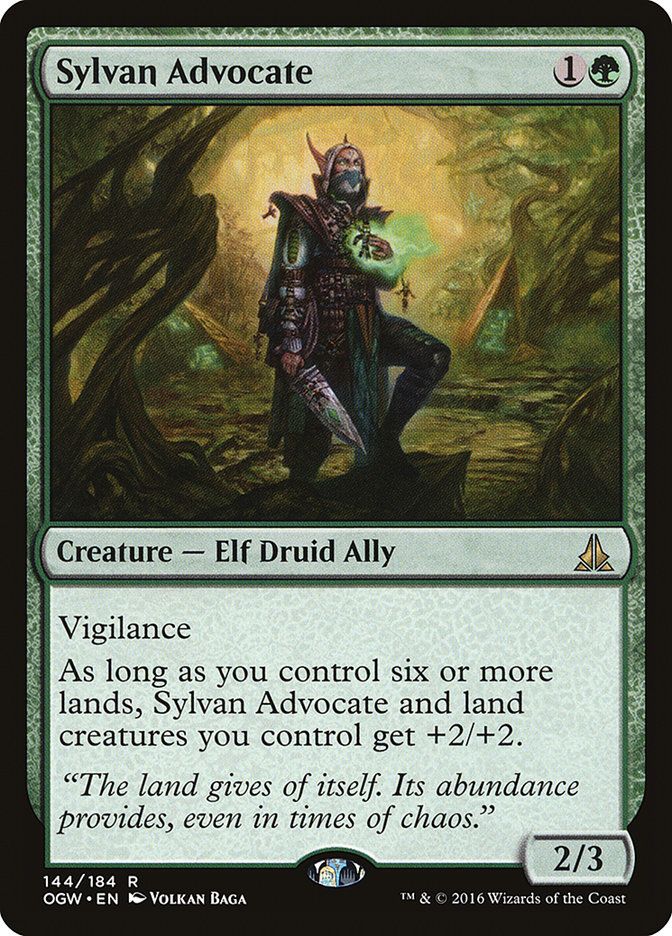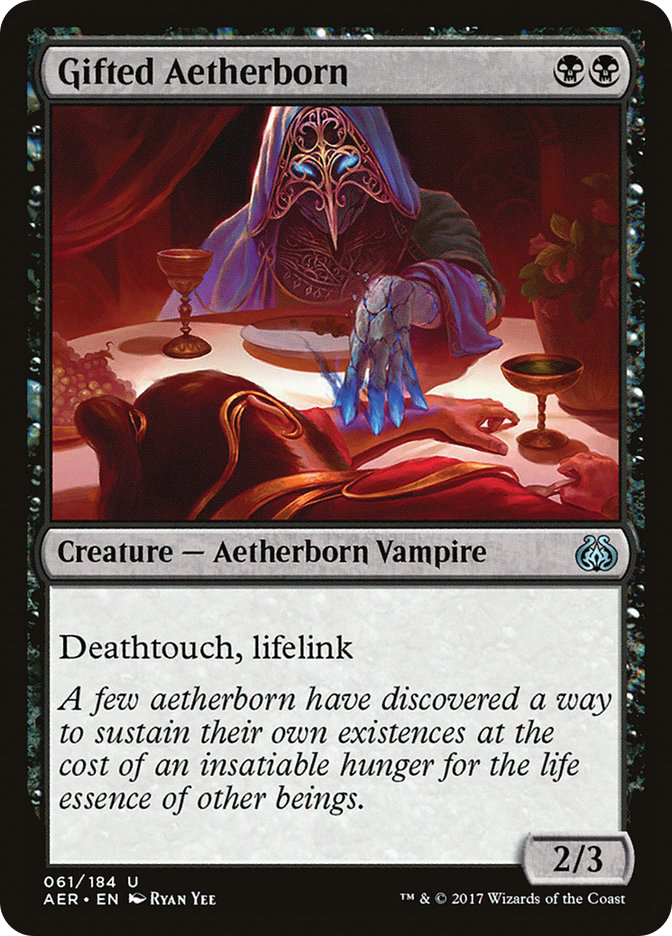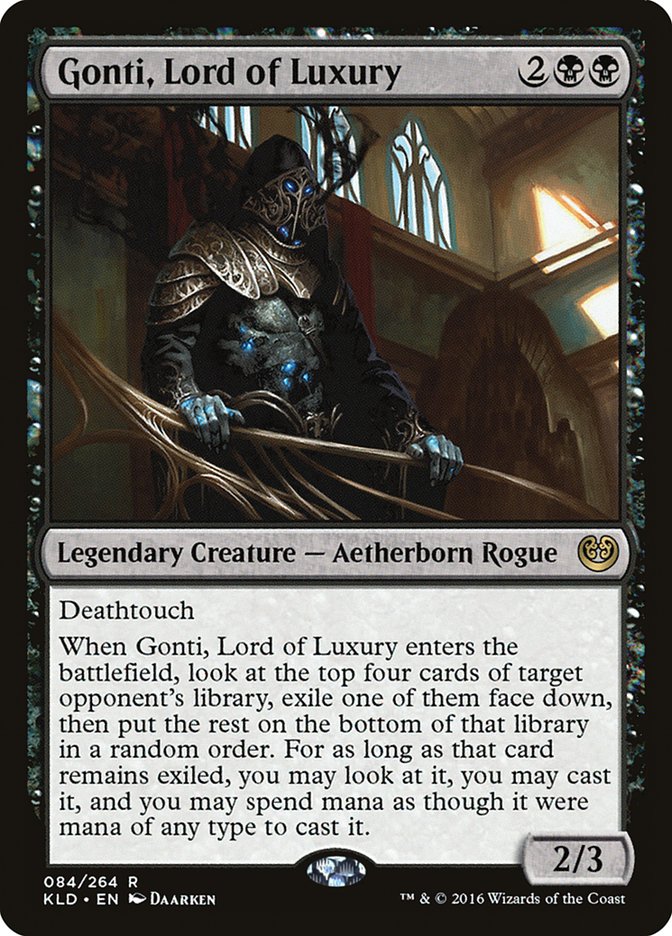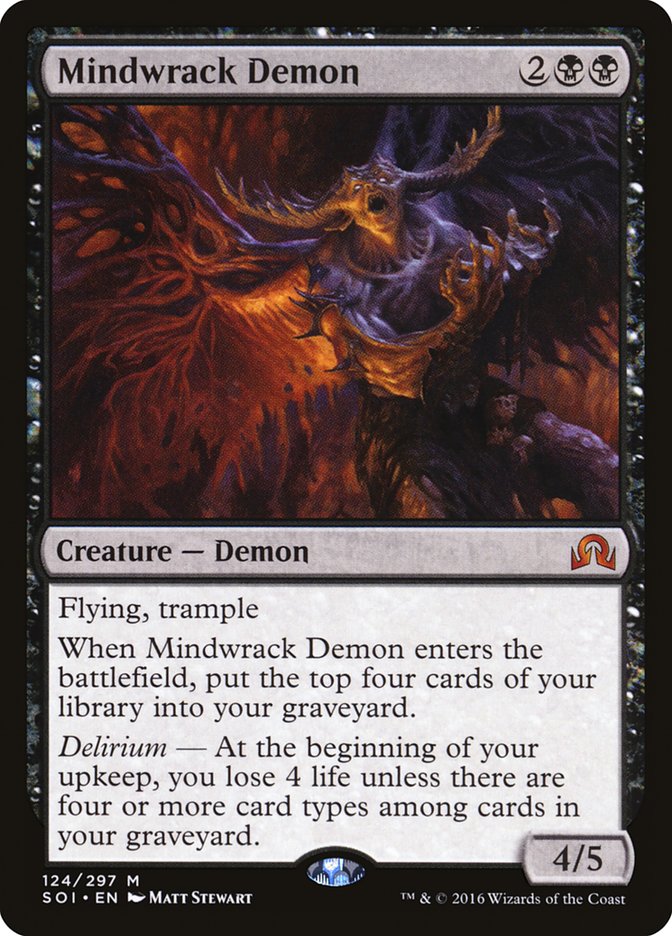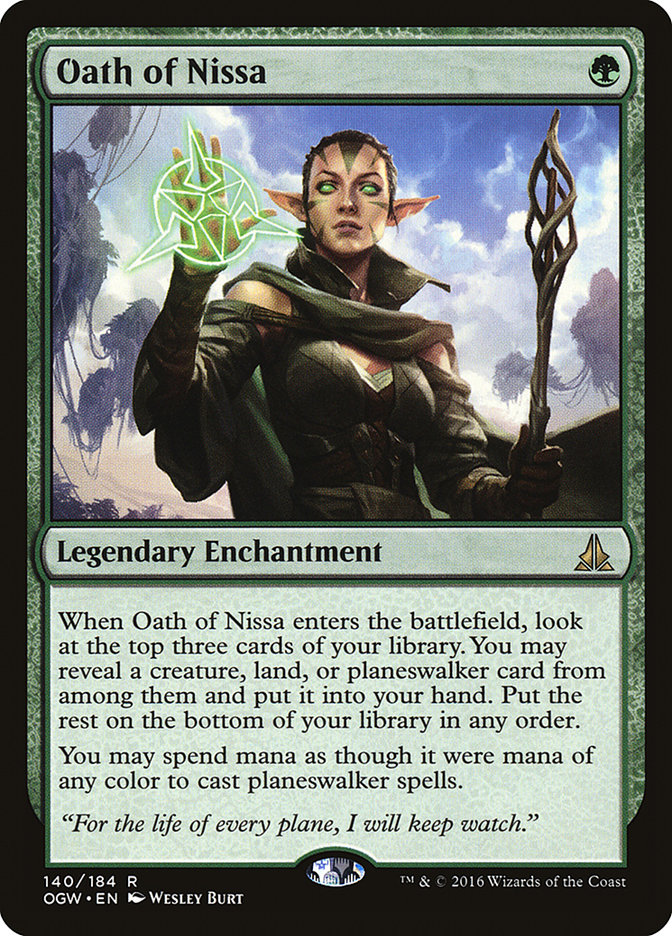Five G/B Aggro decks made the elimination rounds of the Grand Prix last weekend. In and of itself that is an impressive performance, cementing the deck as one of the top two in the format alongside Mardu Vehicles.
Did you catch the mistake?
It’s a subtle one, but one that underscores the key dynamic at play in Standard right now. I said the deck. As though it were a singular entity. The truth is G/B Aggro is an umbrella term that encompasses a wide array of variants on an archetype that is centered around Winding Constrictor; Walking Ballista; Rishkar, Peema Renegade; and Verdurous Gearhulk.
Creatures (21)
- 2 Catacomb Sifter
- 4 Sylvan Advocate
- 4 Verdurous Gearhulk
- 4 Winding Constrictor
- 3 Rishkar, Peema Renegade
- 4 Walking Ballista
Planeswalkers (3)
Lands (24)
Spells (12)

Creatures (25)
- 3 Verdurous Gearhulk
- 3 Longtusk Cub
- 4 Greenbelt Rampager
- 4 Winding Constrictor
- 3 Rishkar, Peema Renegade
- 4 Glint-Sleeve Siphoner
- 4 Walking Ballista
Planeswalkers (4)
Lands (20)
Spells (11)

Creatures (25)
- 2 Sylvan Advocate
- 2 Tireless Tracker
- 2 Gonti, Lord of Luxury
- 4 Verdurous Gearhulk
- 4 Winding Constrictor
- 3 Rishkar, Peema Renegade
- 4 Gifted Aetherborn
- 4 Walking Ballista
Lands (24)
Spells (11)

Beyond those four cards, there are more options than I can ever remember a single archetype having to choose from.
Back during the original Ravnica era, there were four or so distinct builds of B/W Aggro decks, all of which utilized Dark Confidant and Ghost Council of Orzhova, but beyond that they were very different. One list played the most powerful creatures, one utilized the Nantuko Husk / Promise of Bunrei synergies, and yet another was built around Tallowisp and powerful Auras. It’s been a while, but I don’t recall any single variant dominating over the others for any prolonged period of time, and after weeks of expecting the metagame to coalesce around a single, best-performing variant of G/B Aggro, I think we’re heading in a similar direction now.
As such, it behooves us to understand what the strengths and weaknesses of our various options are, so that we may make informed deckbuilding decisions based on how the metagame changes from week to week. I’ll be focusing on the threat base of the deck over the removal suite, but you’ll see how the latter plays an important role in evaluating the former.
Before I get into individual cards, I’ll briefly state where I think the metagame currently stands, which will inform deckbuilding decisions at the current moment. In the wake of the Pro Tour, the format has shifted from a battle between G/B and Jeskai to one between G/B and Mardu. The aggressive decks have taken over, and while Jeskai and other decks like Four-Color Saheeli and U/R Dynavolt Tower exist and should be accounted for, they are certainly a tier below those top two decks.
A format dominated by aggressive decks means I want to be especially mindful of my curve while having powerful cards to draw to should the game go long. Fatal Push grew in popularity last weekend as players looked to the most efficient removal spell for the creatures everyone is playing, and an increase in removal, however slight, will cause games to go long. It’s a tough balance between not wanting to fall behind on the battlefield early but not sacrificing too much of your long-game in doing so.
The Mardu Vehicles matchup also got trickier as several players demonstrated a sideboard plan of Fumigate plus planeswalkers to morph into a control deck. As a result, we have to have a plan against them that isn’t centered around beating cheap creatures in the post-sideboard games while not getting run over in Game 1. With these guiding principles in mind, let’s look at our options, starting at the bottom of the curve.
The Energy Creatures
It would be easy to consider these entirely as a package if they all appeared as a group, but it’s not quite that simple, with players picking and choosing exactly how devoted to the energy theme they want to be. Brad Nelson uses just Glint-Sleeve Siphoner and Servant of the Conduit in his twelfth-place list, while Robert Beatty plays all of them but Servant of the Conduit in a list more devoted to energy.
The energy theme offers some attractive elements, first among them the efficient bodies of Greenbelt Rampager and Longtusk Cub. Fatal Push has seen increased play as players look to lower their curves to get ahead in aggressive mirrors and Greenbelt Rampager serves the same purpose. Being able to play two spells on turn 3 and another two spells on turn 4 can end games before they even begin.
Longtusk Cub may not cost one mana, but it has a similar snowball effect. With supplementary energy sources or a removal spell, getting it through once shouldn’t be too difficult, and each attack makes attacking again easier by pumping the Cub. Combine this with a Winding Constrictor and your two-mana creature can become a 6/6, 8/8, or even 10/10 very quickly.
The downside to these two is what happens when things don’t go according to plan. Neither is a particularly good late-game topdeck unless you have a large store of energy available, and should your opponent thwart your attempts to connect with Longtusk Cub early, it only gets more difficult to connect with it late. Moreover, the rise of Fatal Push means that it’s risky to invest a lot of resources in making a large Longtusk Cub, since one mana and one card is all your opponent needs to undo your investment.
Servant of the Conduit has a similar issue, as it’s excellent on turn 2 but has high diminishing returns after that, and the increased focus on beating aggressive decks means that early leads are less reliable than they were a week or two ago. Glint-Sleeve Siphoner is the real prize of the bunch, since it has the potential to dominate a game with its card advantage, which can both help ensure that you curve out smoothly in the early-game and leave you with a resource advantage should the battlefield trade off in an attrition war.
In order to access such a powerful tool, you must make two concessions. First, you have to support it with some other energy source. Servant of the Conduit is likely the best support card in this role since it plays nicely by itself and being able to draw a card with the energy can take the sting out of having a Runeclaw Bear later in the game. Second, you have to accept that you’re going to lose your Glint-Sleeve Siphoner to a Walking Ballista counter some portion of the time. Trading equally on turn 2 isn’t a big issue, but if they get to cast a two-counter Ballista on turn 3 or 4 and kill your creature without losing theirs, it’s going to hurt.
As a result, I like pairing Glint-Sleeve Siphoner with at least three, and potentially four, copies of Rishkar, Peema Renegade. The additional counter insulates the Siphoner from Walking Ballista and the extra mana that Rishkar provides helps you to better leverage the additional cards you’ll be drawing.
There is one undersung advantage to playing these energy creatures and it’s Aether Hub. Having a third two-color land, and one that always enters the battlefield untapped at that, is a significant boost to the deck’s consistency, and being able to curve out consistently is critical in aggressive mirrors. If you’re looking to stretch your mana with lots of BB and GG cards, you would be wise to fill out your curve with some energy sources to work the additional fixing into your deck.
The Delirium Creatures
Grim Flayer is likely the most popular supplementary two-drop right now. Like Longtusk Cub it depends on you being able to force it through early, but the payoff is much higher if you do. Achieving delirium turns Grim Flayer into a battlefield-dominating body that accepts +1/+1 counters readily because of its trample, and the card selection ensures your draw will be smooth.
But while watching coverage last weekend, it was striking to me how difficult achieving delirium was for these decks. These aren’t the days of Vessel of Nascency and Grapple with the Past. Evolving Wilds is a rarity in these decks and Mindwrack Demon is becoming less common, so you’re almost entirely dependent on Grim Flayer hitting the goods. Without seeing Verdurous Gearhulk early, finding four types is going to be hard, and putting them in the graveyard often requires binning a card you’d rather draw.
And all of this ignores the fact that Grim Flayer often runs into the same issues as Longtusk Cub. As we’ll see in the next section, 2/3 bodies were a lot more common last weekend and I saw a lot of Grim Flayers on the “can’t attack, can’t block” plan, which is something we’d all like to avoid. I’m expecting Grim Flayer to decline in popularity in the coming weeks as players look for more consistently powerful options that don’t constrain their deck construction as much.
However, if you’re committed to the delirium plan, Scrapheap Scrounger is a solid option. It’s an artifact for delirium, great in longer games, and gives you some incidental value in combination with Grim Flayer and Mindwrack Demon. As the metagame has become more aggressive and less controlling, Scrapheap Scrounger’s stock has fallen somewhat since its inability to play both ways in combat is a liability against other creature decks, but it’s an obviously powerful card that at the very least should be kept in mind if the metagame ever turns toward control decks.
The Combat Champions
Neither of these cards saw much play at the Pro Tour, but both were out in force last weekend in Pittsburgh. I talked earlier about wanting to have a deck that will not fall behind early and also not lose longer games because its cards are underpowered, and having two-drops that are relevant past turn 6 is one of the best ways to do that.
Both of these creatures are going to make their presence known on the battlefield regardless of the game state and they play offense and defense simultaneously through vigilance and lifelink. Playing both ways makes them excellent targets for +1/+1 counters, which is a nice bonus.
You’re not getting any fantastic synergies here, just great rate, and while the former tends to be more exciting, the latter tends to win more games. As I’ve noted several times, players are coming with more and more cheap removal to answer efficient threats, which makes assembling synergies more difficult. But if you’re jamming only the highest-impact threats, you know that whatever creature is left over is capable of winning the game.
I’m a fan of both creatures, although Sylvan Advocate being easier on the mana makes me give it a slight edge. I’d side toward Gifted Aetherborn if you’re building your deck to be more defensive, but I wouldn’t be opposed to fitting both in your list and having a lower curve without sacrificing much late-game power.
The Three-Drops
These four are listed specifically in the order in which I like them. Tireless Tracker is my pick for best three-drop, and given its pedigree that’s no surprise. There’s just never going to be a format where a sizable body that gives you free resources for doing something you’ll do anyway (playing lands) will be bad.
The Clues give you some insulation against anyone who wants to beat you with removal and the body eventually dominates the battlefield. As a bonus, sacrificing a Clue turns on revolt for your Fatal Pushes. Note that Tireless Tracker works particularly well with Servant of the Conduit, since the acceleration lets you cast your Tracker on turn 3 and immediately get a Clue from it while hopefully using the mana on a Fatal Push.
In a faster format, the 3/2 body can sometimes be a liability while the Clues are too slow, but we’re at the point where the format is slowing down because everyone is reacting to the influx of aggressive decks. This is the time where Tireless Tracker is at its best because it can seamlessly switch between roles.
Aethersphere Harvester is the other big payoff for going the energy route, as its body absolutely dominates combat. Throw a +1/+1 counter or four on it and you have yourself a Baneslayer Angel that you can leave dormant should your opponent leave up their mana for a removal spell. Unlike some of the other energy cards, this one doesn’t need much to work efficiently, and I’d be interested in seeing what the minimum level of support is since the payoff here is so much higher than for the others.
Having a sizable Vehicle threat is one of the better ways to insulate yourself from Fumigate and the flyer pressures planeswalkers well, making this one of the best options against Mardu Vehicles. If your metagame is more Mardu-heavy than most, look no further.
Nissa, Voice of Zendikar is the other threat that helps out against Fumigate, although you trade some of the immediate pressure from Aethersphere Harvester for long-term advantage. The “+1, -2, -2” sequence is quite common, especially if you have some combination of Walking Ballista and Winding Constrictor on the battlefield, as the synergy can run away with a game quite quickly.
My concern with Nissa, Voice of Zendikar is how poor it is on the draw. The immediate impact it has is minimal, with the 0/1 Plant often relegated to chump blocking duty so you can generate another one on the following turn. If you never turn the corner with it, then it often just prolongs its inevitable death, leaving you with no value three or four turns down the road. Of course, it’s a lot harder to turn the corner on the draw, leaving it a liability in the games where it’s most important to be at your best.
As a result, I wouldn’t want to play more than a couple of copies of the card so that it’s not too cumbersome to sideboard out if necessary.
I won’t spend much time on Catacomb Sifter here; suffice it to say that I’m not a fan. Accelerating into Verdurous Gearhullk is nice, but Rishkar, Peema Renegade and Servant of the Conduit are better ways of doing so and the body gets outclassed too quickly for a three-drop. It plays nicely with Nissa, Voice of Zendikar, but between those two, Rishkar, and Tireless Tracker, there just isn’t room to fully explore the synergy.
The Four-Drops
Given the power of the cheaper cards and the rising use of Fatal Push, any four-mana creature has taken a hit in playability, so I’d advise limiting the number of any of these and strongly consider playing none of them.
Gonti, Lord of Luxury is the top of the list for me because the deathtouch body forces a removal spell, while its second ability ensures there is some value left behind. You may fall behind on tempo as they use a one- or two-mana spell to remove your four-mana creature, but so long as you prioritize taking a cheap spell, Gonti can help you recoup that tempo while leaving you a card ahead.
Kalitas, Traitor of Ghet and Mindwrack Demon can both take over a game should things break correctly, but it’s very difficult for that condition to be met. Kalitas, Traitor of Ghet needs you to untap with it and some removal (when it dies to every removal spell), while Mindwrack Demon needs you to be able to spend a full turn on a threat while maintaining parity on the ground so it can go to work in the air. The fact that it gets stopped by Aethersphere Harvester makes me think this is only for lists that really want to hit delirium.
After looking through all the lists and considering all the cards, there are two lists of B/G from the Grand Prix that I like more than the rest. The first is Brad Nelson’s B/G Energy. He was very high on his list after the Pro Tour and put up another solid finish while changing very little. And if you think I’m showing some pro-SCG bias, please understand that no one likes telling Brad he’s right about anything less than I do. You don’t have to live, work, or travel with him and his smug face.
His list has an incredibly low curve with sixteen-one drops, but Gonti, Lord of Luxury; Tireless Tracker; and Glint-Sleeve Siphoner keep the cards flowing so you always have something to do with your mana. I wouldn’t mind another maindeck removal spell, but with four in the sideboard, you’re well set up to play reactively when necessary.
The other list I like is Ryan Hare‘s winning list. It may seem a little awkward to put in all the work analyzing the cards just to come to the conclusion that the best-performing list and the list from the highest-profile player are the best, but I’m going to take that as a sign that I’m on the right track.
I may not like every card in Ryan’s list and I think the curve is a smidge high, but all the cards make sense and work cohesively. In particular, Ryan took care to support his copies of Nissa, Voice of Zendikar with Catacomb Sifter and the full set of Sylvan Advocates. We know from the days of G/W Tokens that Sylvan Advocate / Nissa, Voice of Zendikar is a strong opening, since Sylvan Advocate plays offense and defense.
I’m also more than a little biased towards Oath of Nissa. With your opening development being so important having a card that smooths out your draws while being good off the top later on is very important, and there will always be the games where you have two Swamps and want to cast Nissa, Voice of Zendikar on turn 3. It’s easy to underestimate the efficacy of such a marginal effect, but over eighteen rounds, that additional consistency adds up.
The craziest part of this article to me is that I’ve only scratched the surface on the choices for B/G decks. There are plenty of good removal spells to choose from, manabase and land count, and sideboards which could take another article or two to cover fully. There’s just so much going on in the span of one archetype.
Maybe will someone come along this weekend or next with a “best” build of the deck, but more likely than not, you’ll have to put in the work to learn the subtleties of all the different versions and card choices. Hopefully this has been a good start to that process.




